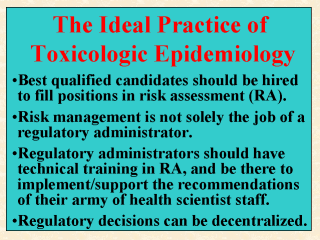| front |1 |2 |3 |4 |5 |6 |7 |8 |9 |10 |11 |12 |13 |14 |15 |16 |17 |18 |19 |20 |21 |review |
 |
The discussion
in the last slide has a great implication for the development of toxicologic epidemiology.
Unless job announcements in exposure assessment or risk assessment (RA) are made available
more directly to the right group of graduates, less qualified candidates will fill these
positions. The resultant situation is no less problematic than, say, appointing a
urologist to head a gynecology unit, no matter how much managerial training this person
has. Nearly two decades ago when the National Research Council (NRC, 1983) developed the RA paradigm, they drew a line between the practice of risk assessment and that of risk management. NRC and especially their followers have been working around this paradigm rather religiously, insisting that risk assessment is (solely) the responsibility of the health regulatory scientists and risk management is (solely) that of the regulatory administrators. Granted that pesticides, drugs, and the like should all be treated as economic poisons, their use should still be at the judgment of regulatory scientists, not of those administrators without an adequate training in RA. The politics in RA is beyond imagination. As noted by Ehrlich and Ehrlich (1996), "No dispute over a toxic substance in recent memory has been the subject of so much bombast and erroneous information as the great Alar flap of 1989." Regulatory decisions in RA are often seen as exercised under the pretense of scientific judgement. If regulatory decisions must be centralized without some systemized procedures, then the few administrator generals are necessarily overwhelmed by a flood of confusing inputs from their army of scientists. |